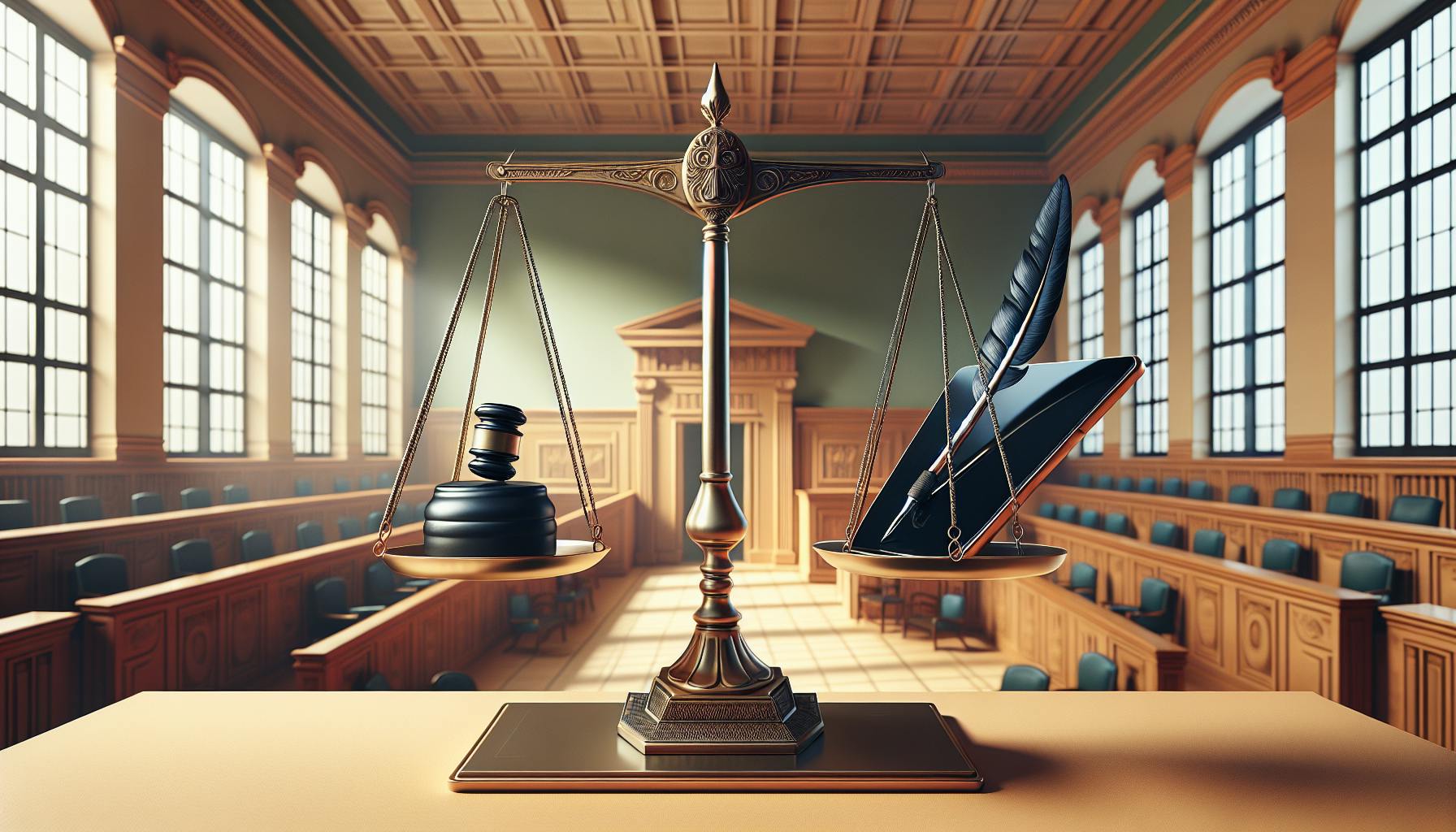Most would agree that slavery has a complex and painful history in America, one that raises difficult questions about equality, human rights, and justice.
The Thirteenth Amendment marked a pivotal turning point by finally abolishing slavery, offering hope for a more just society.
This article will provide an in-depth look at the Thirteenth Amendment - its historical context, passage, and enduring legacy in the ongoing struggle for civil rights in America.
Introduction to the Thirteenth Amendment and the Abolition of Slavery
The Thirteenth Amendment, ratified on December 6, 1865, abolished slavery in the United States. This amendment was the culmination of decades of work by abolitionists and represented a major milestone in ensuring equal rights and justice.
The Roots of Chattel Slavery in America
Slavery dates back to the earliest British colonies in North America in the early 17th century. The institution became entrenched economically, socially, and politically. Enslaved Africans and their descendants were considered property under the law. By the mid-18th century, slavery was legal in all 13 colonies.
The Rise of the Abolitionist Movement
In the 19th century, the abolitionist movement gained momentum through figures such as William Lloyd Garrison, Angelina Grimké, and Frederick Douglass. Abolitionists gave speeches, published newspapers, and helped slaves escape to the North via the Underground Railroad. This growing movement was critical in turning public opinion against slavery.
Legislative Precursors to the Thirteenth Amendment
There were many legislative battles related to slavery leading up to 1865. These included the Three-Fifths Compromise, Missouri Compromise, Compromise of 1850, and more. While the abolitionist movement grew, political compromises on slavery persisted until the American Civil War finally brought sweeping change.
The American Civil War: Catalyst for Change
The election of President Abraham Lincoln and the secession crisis led to the Civil War beginning in 1861. The Emancipation Proclamation of 1863 freed slaves in rebelling states. As the Union emerged victorious in 1865, the Thirteenth Amendment was proposed and ratified, finally abolishing slavery nationwide. This paved the way for the Reconstruction Amendments and advancement of civil rights.
What did the Thirteenth Amendment abolished slavery?
The Thirteenth Amendment to the United States Constitution abolished the institution of slavery in the United States. Specifically, it states:
"Neither slavery nor involuntary servitude, except as a punishment for crime whereof the party shall have been duly convicted, shall exist within the United States, or any place subject to their jurisdiction."
This amendment was passed by Congress on January 31, 1865 and ratified on December 6, 1865, thereby formally abolishing the practice of slavery and involuntary servitude as legal institutions.
Some key points about what the Thirteenth Amendment accomplished:
-
It ended the legal practice of owning slaves and forcing them to work without pay or consent. This abolished the institution of chattel slavery that existed in the United States prior to the amendment.
-
It outlawed forced labor without proper criminal conviction. The only exception is convicted criminals who can be subject to penal labor as part of their punishment.
-
It freed all remaining slaves after its ratification. This completed the emancipation process started by President Lincoln's Emancipation Proclamation during the Civil War.
-
It enabled Congress to pass enforcement legislation to fully implement abolition. This led to Civil Rights Acts and other measures to protect the rights of former slaves.
So in summary, the Thirteenth Amendment was a landmark achievement that officially and permanently abolished the institution of slavery throughout the United States. It freed millions of slaves and paved the way for them to build lives as free citizens.
What is the 13th Amendment in simple terms?
The 13th Amendment is the constitutional amendment that abolished slavery in the United States. Here is an overview of the 13th Amendment in simple terms:
-
It was passed by Congress on January 31, 1865 and ratified on December 6, 1865.
-
The 13th Amendment states: "Neither slavery nor involuntary servitude, except as a punishment for crime whereof the party shall have been duly convicted, shall exist within the United States, or any place subject to their jurisdiction."
-
In basic terms, it made slavery and involuntary servitude illegal, with the exception of penal labor as punishment for a crime.
-
It applied to all U.S. states and territories, abolishing slavery nationwide.
-
It overturned key parts of the 1857 Dred Scott Supreme Court decision that said African Americans could not be citizens.
-
It nullified the 1850 Fugitive Slave Act that required the return of escaped slaves.
-
The 13th Amendment was an important step toward ending racial inequality and the vestiges of slavery after the Civil War.
-
It was followed by the 14th and 15th Amendments as part of the Reconstruction Amendments to guarantee civil rights and equality.
So in short, the 13th Amendment officially and constitutionally abolished the institution of slavery throughout the United States. It marked a pivotal turning point in the long struggle to end slavery and establish equal rights.
How many slaves did the 13th Amendment free?
The Thirteenth Amendment, ratified on December 6, 1865, abolished slavery in the United States. This monumental amendment freed approximately 4 million African American slaves, representing almost one-third of the Southern population at the time.
Specifically, Section 1 of the Thirteenth Amendment states:
"Neither slavery nor involuntary servitude, except as a punishment for crime whereof the party shall have been duly convicted, shall exist within the United States, or any place subject to their jurisdiction."
This effectively abolished the institution of slavery that had existed in the United States since the early 17th century. While the Emancipation Proclamation of 1863 had declared slaves in Confederate states to be free, it did not apply to Border States and had no constitutional backing.
The Thirteenth Amendment resolved this by finally providing constitutional authority to abolish slavery nationwide. As such, it completed the long journey toward freedom for millions of enslaved African Americans that had begun decades earlier with the early abolitionist movement.
The amendment thus represented a major milestone in American history. Its ratification marked the culmination of decades of struggle and activism. With four million former slaves now free citizens, the Thirteenth Amendment paved the way for the Reconstruction Amendments and civil rights legislation that followed. Its impact continues to reverberate today.
sbb-itb-585a0bc
sbb-itb-585a0bc
sbb-itb-585a0bc
sbb-itb-585a0bc
Was slavery unconstitutional before the 13th Amendment?
Prior to the ratification of the Thirteenth Amendment in 1865, slavery was considered constitutional and was protected by the original Constitution through provisions such as the Three-Fifths Compromise and the Fugitive Slave Clause.
However, there was significant debate around the constitutionality of slavery even in the early days of the nation. Key points in this debate include:
-
The Declaration of Independence stated that "all men are created equal" and have "unalienable rights" to "life, liberty and the pursuit of happiness." This founding principle clashed with the existence of slavery.
-
Many of the Founding Fathers, including Thomas Jefferson and Benjamin Franklin, were morally opposed to slavery and hoped it would eventually be abolished through legal means. However, they made compromises to appease slave-owning states.
-
The Northwest Ordinance of 1787 banned slavery in new western territories, showing early attempts to limit its spread. This laid important groundwork for containing and ultimately abolishing slavery.
-
Abolitionists like William Lloyd Garrison argued that slavery violated basic constitutional rights and could not be morally reconciled with American ideals of freedom and equality.
So while the original Constitution did sanction slavery through key provisions, there was ongoing dispute about its fundamental constitutionality from the nation's earliest days. The Thirteenth Amendment resolved this dispute by finally outlawing slavery through constitutional means.
Drafting and Ratification of the Thirteenth Amendment
The Thirteenth Amendment to the United States Constitution abolished slavery and involuntary servitude, except as punishment for a crime. It was passed by Congress in January 1865 and ratified by the required number of states in December 1865.
Prohibiting Slavery and Involuntary Servitude
The Thirteenth Amendment states:
"Neither slavery nor involuntary servitude, except as a punishment for crime whereof the party shall have been duly convicted, shall exist within the United States, or any place subject to their jurisdiction."
This amendment enshrined in the Constitution the abolition of slavery and prohibited treating human beings as property that could be bought, sold or forced to work without pay. It marked a pivotal moment in American history.
The 38th United States Congress and the Amendment's Approval
The Thirteenth Amendment originated in the 38th United States Congress, which had a Republican majority committed to the abolition of slavery. Key congressmen who pushed the amendment included Senator Charles Sumner of Massachusetts and Representative Thaddeus Stevens of Pennsylvania.
Despite opposition, the amendment passed the Senate on April 8, 1864, and the House on January 31, 1865. It was then sent to the states for ratification. By December 6, 1865, the necessary 27 of 36 states had ratified it, making the amendment official.
Lincoln's Leadership and the Election of 1864
President Abraham Lincoln's leadership was crucial to the amendment's passage. He had issued the Emancipation Proclamation in 1863 declaring slaves in Confederate states to be free. Lincoln pressed Congress to propose a constitutional amendment abolishing slavery nationwide.
Lincoln's re-election in 1864 gave momentum to the amendment's approval. Voters endorsed his anti-slavery position and empowered the Republican Congress to pass the amendment early in 1865.
Debates Over Federalism vs. States' Rights
Passage of the Thirteenth Amendment sparked debates about federalism and states' rights. Opponents argued the federal government was overreaching into matters traditionally left to the states. Supporters countered that individual liberties should not vary by state and the abolition of slavery should be enforced nationally.
The amendment's passage demonstrated the federal government's authority to set baseline civil liberties protections for all Americans regardless of state laws. This established an important precedent for future civil rights reforms.
The Thirteenth Amendment's Immediate Aftermath
The Thirteenth Amendment, ratified in December 1865, abolished slavery and involuntary servitude in the United States. Its passage marked a pivotal moment in American history, bringing about the end of the Civil War and beginning the Reconstruction era.
Emancipation and the End of Slavery in the United States
On June 19, 1865, Union General Gordon Granger arrived in Galveston, Texas to enforce the Emancipation Proclamation. His announcement finally freed the last 250,000 slaves in Texas, making emancipation complete across the former Confederate states. The date has since become known as "Juneteenth," commemorating the true end of chattel slavery in America.
However, the path to equality was just beginning. While legally free, most former slaves emerged from bondage with no land, money, education or other resources. Southern whites sought to maintain control through racist "Black Codes," restricting rights like voting, property ownership and even the right to travel. The Union army worked to protect freedmen's rights, but it would take years to overcome resistance.
Reconstruction and the Fight for Civil Rights
In the wake of the Civil War, the Reconstruction Amendments abolished slavery, granted citizenship and equal protection under the law regardless of race, and prohibited racial discrimination in voting rights. Despite these protections, discrimination and racist violence persisted.
The Civil Rights Act of 1866 aimed to guarantee key civil liberties for African Americans, though its effects were limited. Stronger civil rights legislation like the Enforcement Acts helped curb violence and protect voting rights, but these too had mixed success. The broader Reconstruction project ultimately crumbled amidst political disputes and a lack of long-term federal commitment.
The Black Codes and the Struggle for Equality
When President Andrew Johnson assumed office after Lincoln's assassination, he enabled Southern states to enact "Black Codes" restricting freedmen's rights. These codes compelled African Americans to sign year-long labor contracts, banned "vagrancy," and curtailed rights like bearing arms and testifying against whites in court. Though the Union army overturned the harshest codes, they set a precedent of legalized racism that continued for generations.
In the late 19th and early 20th centuries, practices like peonage and convict leasing essentially perpetuated slavery through forced, unpaid prison labor. This evolution into contemporary forced labor issues like sex trafficking demonstrates the ongoing struggle for true equality under the law. The Thirteenth Amendment was a start, but the fight continues even today.
The Long-Term Legacy of the Thirteenth Amendment
The Thirteenth Amendment, ratified in 1865, abolished slavery and involuntary servitude in the United States. However, its legacy extends far beyond 1865.
Continuing Challenges: Jim Crow and Beyond
Despite the abolition of slavery, African Americans continued to face discrimination and inequality for generations after the Civil War. Southern states enacted "Jim Crow" laws enforcing racial segregation. Additional civil rights legislation and Supreme Court rulings were needed over the next century to more fully realize the Amendment's promise of freedom and equality. Work remains to be done to address continuing injustices.
Landmark Legal Decisions: Brown v. Board and Jones v. Mayer
Key court decisions like 1954's Brown v. Board of Education, which deemed racial segregation in public schools unconstitutional, and 1968's Jones v. Alfred H. Mayer Co., which upheld that the Thirteenth Amendment bars all racial discrimination in property sales, built upon the original Amendment to advance civil rights. These rulings showed the enduring legal impact of the original Amendment's prohibition on slavery and set further precedents.
Modern Interpretations and Enforcement Legislation
In recent decades, the Thirteenth Amendment has been interpreted to prohibit not just legal slavery but also forced labor in all forms. Federal legislation has been passed to enforce bans on human trafficking and forced labor practices. So while the Amendment was written over 150 years ago, it continues to have modern relevance.
Celebrating Freedom: National Freedom Day and Juneteenth
The ongoing influence of the Thirteenth Amendment is marked through commemorations like National Freedom Day on February 1st and Juneteenth on June 19th. These celebrations highlight the Amendment's role in ending slavery and represent how the push for civil rights continues to this day. The Thirteenth Amendment was a landmark moment in America's ongoing journey towards freedom and equality.
Conclusion: Reflecting on the Thirteenth Amendment's Place in History
The Thirteenth Amendment, ratified on December 6, 1865, legally abolished slavery and involuntary servitude in the United States. This was a monumental milestone in the long struggle towards securing civil rights and equality for all Americans.
The amendment nullified the Supreme Court's Dred Scott decision of 1857 which had ruled that African Americans could not be citizens. It overturned the Three-Fifths Compromise that had counted slaves as three-fifths of a person for purposes of representation and taxation. Most significantly, it outlawed the immoral and dehumanizing institution of slavery that had existed in the country for over two centuries.
While the Emancipation Proclamation of 1863 had declared slaves in Confederate states to be free, the Thirteenth Amendment extended this abolition nationwide. Its passage was the culmination of decades of work by abolitionists and civil rights activists. However, the fight did not end there - the injustices of the Black Codes and Jim Crow laws persisted for another century after.
The Thirteenth Amendment reminds us how far we have come as a nation, but also how far we still have to go to achieve true equality and civil liberties for all. Its spirit continues to motivate the ongoing movement for social justice and reform. As Americans reflect on our history, we must acknowledge past mistakes while continuing to build a more just society for future generations.


